Looking closely at students leaving the Black Family Visual Arts Center, one can see charcoal smudges or smeared paint on hands. Voices singing melodies or reciting Shakespeare’s iambic pentameter echo through the rehearsal rooms in the Hopkins Center. Photographers scout views on the Green and film students watch movies in the library with headphones in and eyes rapt.
Although the Hood Museum is currently under renovation and the Hop’s programming is limited, the arts are very much alive on campus.
Many of the students taking classes in the arts echoed sentiments regarding the amount of time needed to complete work in their respective departments.
To fulfill the art distributive, Andie Conching ’18 is taking “Drawing I” to explore an interest she has never taken formal classes in.
Each project requires dedicated time — an unexpected commitment that makes the class more challenging than Conching expected.
Brandi Reano ’18 is taking two studio art classes this term: “Drawing I” and “Printmaking I: Etching.”
Both classes, she said, are challenging in their own ways and require a lot of time, work and concentration.
Marina Van Pelt ’18 is currently taking “Photography I,” her second course in the studio art department.
After taking “Drawing I” during her freshman spring, Van Pelt knew to expect to spend most of her time during the week in the photography studio developing and printing her photos.
Despite the extensive time it may take to complete an assignment in these courses, the students find the results meaningful.
“It’s cool to see the finished products and how you’ve been progressing throughout the course,” Conching said.
Though printmaking is harder for her than drawing, Reano enjoys both because they involve creating a design from her imagination to symbolize a form and drawing perceptions from real life.
Claire Feuille ’18 and Sadhana Puri ’18 are taking “New Plays in Development,” the only theater course offered this summer.
To help develop her character for the upcoming Loring Dodd performance, Feuille is incorporating skills she learned from “Acting I,” a course she called both her most time-consuming and most rewarding.
“I’m using the same techniques that I learned in terms of coming up with a back story for the character and who she is,” Feuille said.
The small size of the theater course fosters relationships among the students. This past weekend, Puri recalled, she and the other seven members of her class traveled to the Williamstown Theatre Festival in Williamstown, Mass. and bonded during the two-hour car ride.
For some students, arts classes lead to new discoveries.
As an avid guitarist, Andrew Shipman ’18 is taking “Beginning Music Theory” because he wanted to learn and understand the mechanics of putting chords together.
Balancing textbook work and piano lessons for the course is a lot of work, he said, but not that difficult to do.
A math major, Shipman deepened his enjoyment of music theory more after realizing how much math is involved in it.
Before the summer, Puri took “Playwriting I” and “Playwriting II,” but she realized she never got to experience the reality of producing a script in real life. She said “New Plays in Development” exposed her to the myriad components that need to come together to produce a full production such as lighting, sound and stage management.
“I’m really happy that I get to see the multifaceted side of theater,” Puri said.
For a photography project focused on trees, Van Pelt learned how to take photos at different angles while incorporating natural sunlight and shadows.
“Finding different ways to take pictures of trees was fun,” Van Pelt said. “Normally you look past them, but when you’re focusing and taking a picture you see more beauty in them.”
Through her film viewings and class discussions in “Asian Animation,” Hannah Nam ’18 learned about the interdisciplinary nature of the film and media studies department.
Most of the work in “Asian Animation,” she said, is very creative but not limited to one particular field.
“We get to use so many media forms so it’s not necessarily just film or audio,” Nam said. “There’s a lot of art in it as well so we do drawing and creative writing.”
In “Introduction to Television,” Alex Adams ’18 has learned about the behind-the-scenes aspects of producing shows including camera work, set production, sound and marketing.
“It’s different to analyze TV because you never watch it and think about all the details that go into making the show,” she said.
Adams recently completed a paper that compared two shows — one shot with multiple cameras and one shot using a single camera.
“I analyzed how they vary in set design and theatrics, which complement the genre,” she said.
Regarding how students choose which of these classes to take and when to take it, the consensus is to take a course in the arts that one finds interesting and that provides balance to an overall term load.




